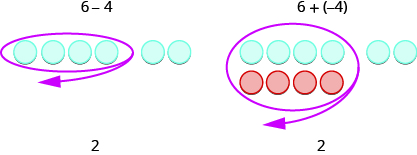| << Chapter < Page | Chapter >> Page > |
Subtract: ⓐ ⓑ
ⓐ
| Take 1 positive from the one added neutral pair. |

 |
−3 − 1
−4 |
ⓑ
| Take 1 negative from the one added neutral pair. |

 |
3 − (−1)
4 |
Have you noticed that subtraction of signed numbers can be done by adding the opposite ? In [link] , is the same as and is the same as You will often see this idea, the subtraction property , written as follows:
Subtracting a number is the same as adding its opposite.
Look at these two examples.

Of course, when you have a subtraction problem that has only positive numbers, like you just do the subtraction. You already knew how to subtract long ago. But knowing that gives the same answer as helps when you are subtracting negative numbers. Make sure that you understand how and give the same results!
Look at what happens when we subtract a negative.

Subtracting a negative number is like adding a positive!
You will often see this written as
Does that work for other numbers, too? Let’s do the following example and see.
Let’s look again at the results of subtracting the different combinations of and
When there would be enough counters of the color to take away, subtract.
When there would be not enough counters of the color to take away, add.
What happens when there are more than three integers? We just use the order of operations as usual.
Access these online resources for additional instruction and practice with adding and subtracting integers. You will need to enable Java in your web browser to use the applications.

Notification Switch
Would you like to follow the 'Elementary algebra' conversation and receive update notifications?